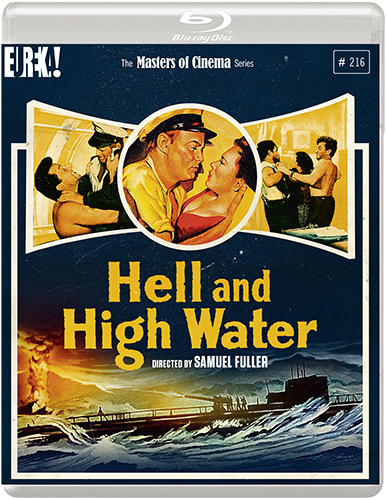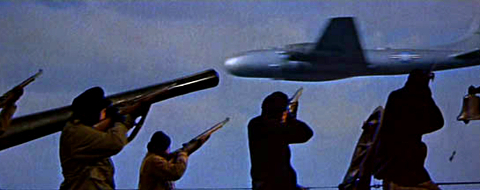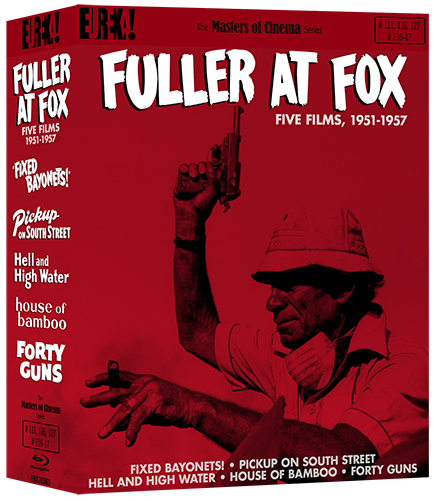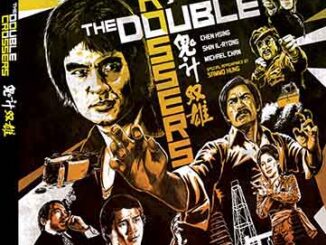Hell And High Water (1954)
Directed by: Samuel Fuller
Written by: David Hempstead, Jesse Lasky Jr, Samuel Fuller
Starring: Bella Darvi, Cameron Mitchell, Richard Widmark, Victor Francen
USA
AVAILABLE ON BLU-RAY: November 11th, in the FULLER AT FOX, FIVE FILMS 1951-1957 Boxset, from EUREKA ENTERTAINMENT
RUNNING TIME: 103 mins
REVIEWED BY: Dr Lenera, Official HCF Critic
1953: Former U.S. navy submarine commander Adam Jones arrives in Tokyo after receiving a mysterious package containing $5,000. There, he meets Professor Montel and his four colleagues. They think the Communist Chinese are building an atomic base on an island somewhere north of Japan, so Montel offers Jones another $45,000 if he will command a World War II Japanese submarine being overhauled and follow the Chinese freighter Kiang Ching which has been making suspicious deliveries in that area. Jones reluctantly agrees, though the Kiang Chinjg suddenly leaves and the submarine has to sets off without being fully armed. And also along for the ride is Montel’s assistant Professor Denise Gerard, even though the crew believe that a woman on board is bad luck….
Eureka Entertainment’s latest box set is devoted to Samuel Fuller, a film-maker who wasn’t always appreciated in Hollywood, but who began to gain great critical respect in the 1960’s [firstly it seems from the French, often seemingly on the ball with cinema – they were really the first to truly see Alfred Hitchcock for the genius that he was, and Lucio Fulci is regarded as a major artist] and is now highly regarded by many for his unique takes on popular genres, handling of sensitive themes and punchy directorial style which largely comes from his early career as a journalist. While I have seen and much liked other films from him such as Shock Corridor, The Naked Kiss, Verboten! and White Dog, the latter a past Eureka release. I hadn’t seen any of the films in this set apart from Fixed Bayonets!, a cracking Korean war movie that was his first major success, and which Eureka didn’t send to me a second time. My review can be read here. Nor did they send the second film Pickup On South Street, probably because it also came out from Eureka a while back, though I didn’t receive a copy back then. Never mind, it’s a busy review week for the Doc, so let’s crack on with the three remaining films, beginning with this one. I always enjoy a good submarine movie, with all that terrific tension that can result as long as the film-makers are doing things properly, and Hell And High Water definitely succeeds in this respect, aided immensely by the greater realism than usual for the time that Fully brings – though elsewhere it’s pretty much hokum, from its hysterical anti-Commie plot to its constant back and forth from appearing to be against war to being all for it – and is proud of it. It might be an adolescent effort with no attempt at depth, but I was thoroughly entertained throughout, Fuller proving himself to be certainly capable of churning out a muscular action adventure that should keep most modern viewers involved.
Fuller agreed to direct the film after Fox studio head Darryl F. Zanuck said that he could rewrite the screenplay as long as the original screenwriters, Jesse L. Lasky Jr. and David Hemstead, approved the rewrite. He wasn’t really too keen on the project, but accepted the assignment as a personal favor to Zanuck, who had defended Fuller against FBI Director J. Edgar Hoover’s attack on the studio over Fuller’s Pickup On South Street. Fuller spent several days aboard a U.S. Navy submarine, including fifteen hours submerged, the experience leading Fuller to add some scenes and stage others in a particular way. When cinematographer Joseph MacDonald said there was no room on the sets for red lighting that he wanted, Fuller said that few in the audience would be familiar with the equipment inside a submarine and therefore had MacDonald place them in the audience’s view. The U.S. government, who also provided the nuclear bomb explosion footage that opens and ends the film, insisted that “certain spectrum colours” be eliminated from the sequence, lest it “could reveal nuclear secrets”. Charles Boyer was originally cast in the role as Professor Montel, but for reasons unclear the part ended up going to Victor Francen. Bella Darvi was only cast as Denise Montel because she was Zanuck’s mistress, and wasn’t liked much on set. The film was a box office success in the United States and abroad, particularly Germany, though peculiarly France banned it on political grounds. Zanuck would often screen the film in CinemaScope to directors who had reservations about working in the widescreen process to demonstrate why its use should not be limited to just epics. And in 1979, when Fuller was filming a cameo in Steven Spielberg’s 1941, Spielberg showed him that he always carried a print of his favourite film in the trunk of his car – which turned out to be Hell And High Water.
So we open with the afore-mentioned nuclear explosion set to some narration telling us that we are going to see “the story of that explosion”, followed by the titles over which the initially sinister, and seemingly rather appropriate one would think, music turns into a typically rousing war movie march, yet we are still seeing footage of the explosion! The music score does this kind of thing throughout, the march often being used when it seems to jar with what’s taking place onscreen. We certainly don’t have one of the great composer Alfred Newman’s better efforts here, and said theme was actually reused from an earlier score, the one to The Fighting Lady. But of course the seeming conflict demonstrated within the score can be applied to the film in general, the way it continually seems to shift in its viewpoint concerning war. Anyway, back to the plot, and we follow a speeding car around some Paris streets before stock shots of some other major cities show us how the news that some scientists and politicians have disappeared develops. It was old fashioned stuff even in 1958, but fits with Fuller’s “stories ripped from the headlines” approach to much of his work. Cut to two people, a fairly elderly man and a pretty young woman, talking in French with no subtitles, and this is a device used in several other scenes. It’s annoying, especially since French people, and non-French people who know French, would be able to understand them, but not people like me. The man is brilliant scientist Professor Montel, the woman his assistant Denise, and I was intrigued to see what Bella Darvi would be like here. She’s hugely criticised for her performance in the previous year’s The Egyptian, but I thought she did well as that film’s cruel seductress. But unfortunately she seems lost playing a more ‘normal’ character, and is only effective when she’s being coquettish. Small surprise that she returned to France after making just one more film in America.
But it probably seems like I’m being too hard on the film too early because it soon begins to work very well. Jones arriving in Japan and finding this secret HQ has a great old-school spy movie feel about it, and I love the idea of this secret organisation comprised of scientists and – well – the few decent politicians around – who are trying to make the world a better place, and without violence. Jones was hoping to meet a friend, but his plane was shot down while he was on a mission. And now Jones is asked to undertake the same mission, but this time in a submarine, and a submarine that’s not fully armed because it has to go forth very suddenly. I’m not sure that an old guy like Montel would be allowed on the mission, and you know that Denise’s presence will attract much interest, though no doubt this is what would happen, men being men and all that. And Darvi is given a good speech to say to her doubters. The hankering that “Ski” Brodski [cult favourite Cameron Mitchell] has for her, so much that he decides to go and learn French, is rather sweet. But another sailor tries to kiss her causing a fight, and today the attentions of Jones, who has questionable lines like, “what makes a girl who looks like that get mixed up with science”, might seem more like sexual harassment – just look at the number of times he grabs her – not to mention the scene where a group of the men are standing outside where she’s taking a shower. I sometimes feels like Fuller is aiming for a Howard Hawks-type dynamic, but nobody talks enough for that. In any case, the sense of claustrophobia one would feel in a submarine is well conveyed, and it mostly feels pretty authentic, the very real set obviously helping here, and, while Jones and Montel do butt heads sometimes, first when Montel fails to wake Jones when a message arrives, there’s far less of the usual, “I’m in command”, “no, I’m in command” stuff.
When a Chinese submarine threatens, the resulting duel is a classic of its kind, bed-wettingly suspenseful as our good guys try to outsmart their opponent and end up on the sea bed as the air is running out. We’ve all seen this before, but rarely as well done. Maybe the method of victory is silly – I don’t know enough about submarines to know one way or the other – but I couldn’t help but be impressed by the excellent model work. After this, we leave the sea to go on land. One action sequence is taken from a film called Crash Dive, though you wouldn’t know it. After this is gets rather James Bondy, with a secret lair and plot to start World War 3. All we miss is a super villain. It’s all pretty exciting, despite one character’s sudden change from pacifist to warrior which feels like a scene was left out. The animated tracer bullets lighting up the scene when Chinese machine guns rake our commandos on the beach are pretty cool, and the sight of everyone in camera blasting away at a plane kind of rousing yet also kind of amusing – but in the best way. Of course elsewhere we’re often given the impression that war is something that should be avoided,yet these scientists still agree with the American military that the United States should have a monopoly on nuclear weapons and anybody else that wants them is an Enemy of Freedom. Meanwhile the Chinese aren’t quite totally evil, though the message still seems to be that Commies are Bad – though I do wonder if Fuller was slightly satirising the idea but didn’t make this clear enough. More notable is the way that violence is coldly, matter-of-factly but subtly presented, especially a prisoner beating to death another and a thumb removed when a hand is stuck in a latch. There’s also quite a powerful moment when Denise shoots someone for the first time and leans against a rock in partial shock, then falls forward when Jones motions her to follow him.
Fuller is less stylish than usual from his other work that I’ve seen, but Richard Widmark perfects his stern delivery and really has a commanding screen presence; he’s pretty cool and it’s fun to just watch him walk about. His best moment is when a prisoner who’s just talked asks him to punch him – and then punch him again – to make it look he gave up the information under torture. Widmark acts very well his character’s hatred of having to do this yet realising its necessity. There are definitely serious moments in Hell And High Water, but in general it’s just pulp escapism which has a sense of its own ridiculousness yet doesn’t quite fall into mockery, instead succeeding in treading what is a very thin line. What could possibly in other hands have been little more than a tedious compilation of things even 1953 audiences had seen a lot of, instead manages to mix equal parts tension, drama, action and romance into a really nifty little package.
I may have to stop describing the picture quality of Eureka Blu-rays because I keep on repeating myself. Many seem to be slightly tweaked – meaning improved – versions of Region A Twilight Time release, and boast very fine detail, grain balance and colour while still looking unmistakably from the era in which they were made. There’s the occasional but bit of black crush, but the slight enhancement of the colours was clearly in the original print. Overall very good.
Eureka have ported over a Widmark programme and added a commentary. The later is by Scott Harrison who also did one on Eureka’s The Night Of The Generals disc. He provides another fairly laid back track that’s nonetheless pretty informative, even if Harrison talks a great deal about Fuller’s career and often prefers to go into related subjects like the Cold War and similar films of the time. I can’t say that I agree with him when he says that Darvi gives a “marvellous” performance, but I do agree with him when he says CGI is over-used and lazily-used today. He claims that Fuller was a major influence on Spielberg, criticises the “men all fawning over the women” bits, and reminds us of those barbaric days when films were always presented on TV and video in pan-and-scan full-screen. A good if not great track. The 1999 TV biographical programme about Widmark may seem a bit fawning to some, especially at the end when everyone says what a nice guy he is, I’ve read several times that he was a nice guy, and it’s still a reasonably overview of his career – albeit with no mention of Hell And High Water! I didn’t know some interesting things like when he lived in Nazi Germany and filmed a Nazi indoctrination school, clips from which are shown. Great friend Karl Malden, Sidney Poitier, Robert Wagner, Eddie Muller and daughter Anne make contributions. Well worth a watch.
FULLER AT FOX, FIVE FILMS 1951-1957 LIMITED EDITION BOX SET [2000 UNITS, INDIVIDUALLY NUMBERED] SPECIAL FEATURES
*All five films presented on Blu-ray in 1080p, with Fixed Bayonets!, Pickup on South Street, Hell and High Water, and Forty Guns presented from Fox’s stunning 4K restorations, with House of Bamboo presented from a 2K restoration
*Original, uncompressed, monaural soundtracks for all films
*Optional English SDH available for all films
*FIXED BAYONETS! – audio commentary by film scholar Adrian Martin
*PICKUP ON SOUTH STREET – Interview with critic, filmmaker and programmer Kent Jones [32 mins]
*PICKUP ON SOUTH STREET – Interview with critic François Guérif [24 mins]
*PICKUP ON SOUTH STREET – “Cinema Cinemas” French TV interview with Samuel Fuller [12 mins]
*HELL AND HIGH WATER – Brand new audio commentary by author Scott Harrison
*HELL AND HIGH WATER – A documentary on lead actor Richard Widmark [45 mins]
*HOUSE OF BAMBOO – Audio commentary with Film Historians Julie Kirgo and Nick Redman
*HOUSE OF BAMBOO – Audio commentary with Film historians Alain Silver and James Ursini
*HOUSE OF BAMBOO – a brand new video essay by David Cairns looking at Samuel Fuller’s films produced for Twentieth Century Fox.
*FORTY GUNS – Audio interview with Samuel Fuller from 1969 at the National Film Theatre in London [80 mins]
*FORTY GUNS – Interview with film critic Jean-Louis Leutrat [17 mins]
*FORTY GUNS – A Fuller Life [80 mins], a feature-length documentary directed by Samantha Fuller
*Original theatrical trailers for all five films
A 100-PAGE PERFECT BOUND COLLECTOR’S BOOK featuring essays by Richard Combs, Murielle Joudet, Philip Kemp, Glenn Kenny, and Amy Simmons; excerpts from Fuller biography A Third Face; and rare archival imagery












Be the first to comment